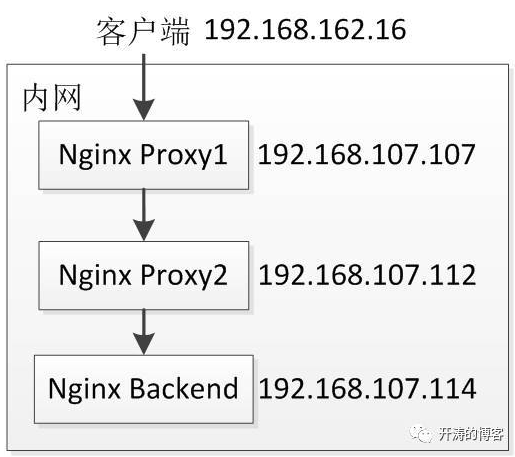如下图所示,客户端通过Nginx Proxy1 和 Nginx Proxy2 两层反向代理才访问到具体服务Nginx Backend(或如Tomcat服务)。那Nginx Backend如何才能拿到真实客户端IP呢?

接下来我们来看看如何才能获取到客户端真实IP。
场景1
场景1是很简单的场景,Nginx Proxy直接把请求往后转发,没有做任何处理。
Nginx Proxy
192.168.107.107 nginx.conf
location /test {
proxy_pass http://192.168.107.112:8080;
}
192.168.107.112 nginx.conf
location /test {
proxy_pass http://192.168.107.114:8080;
}
Nginx Proxy就是简单的把请求往后转发。
Nginx Backend
192.168.107.114 nginx.conf
location /test {
default_type text/html;
charset gbk;
echo "$remote_addr || $http_x_forwarded_for";
}
Nginx Backend输出客户端IP($remote_addr)和X-Forwarded-For请求头($http_x_forwarded_for),当访问服务时输出结果如下所示:
192.168.107.112 ||
分析
$remote_addr代表客户端IP,当前配置的输出结果为最后一个代理服务器的IP,并不是真实客户端IP;
在没有特殊配置情况下,X-Forwarded-For请求头不会自动添加到请求头中,即Nginx Backend的$http_x_forwarded_for输出为空。
场景2
场景2通过添加X-Real-IP和X-Forwarded-For捕获客户端真实IP。
Nginx Proxy
192.168.107.107 nginx.conf
location /test {
proxy_set_header X-Real-IP $remote_addr;
proxy_set_header X-Forwarded-For $proxy_add_x_forwarded_for;
proxy_pass http://192.168.107.112:8080;
}
192.168.107.112 nginx.conf
location /test {
proxy_set_header X-Forwarded-For $proxy_add_x_forwarded_for;
proxy_pass http://192.168.107.114:8080;
}
Nginx Backend
192.168.107.114 nginx.conf
location /test {
default_type text/html;
charset gbk;
echo "$remote_addr ||$http_x_real_ip ||$http_x_forwarded_for";
}
当访问服务时,输出结果为:
192.168.107.112 || 192.168.162.16 || 192.168.162.16, 192.168.107.107
分析
- 在离用户最近的反向代理NginxProxy 1,通过“proxy_set_header X-Real-IP $remote_addr”把真实客户端IP写入到请求头X-Real-IP,在NginxBackend输出$http_x_real_ip获取到了真实客户端IP;而Nginx Backend的“$remote_addr”输出为最后一个反向代理的IP;
- “proxy_set_headerX-Forwarded-For $proxy_add_x_forwarded_for”的是把请求头中的X-Forwarded-For与$remote_addr用逗号合起来,如果请求头中没有X-Forwarded-For则$proxy_add_x_forwarded_for为$remote_addr。
X-Forwarded-For代表了客户端IP,反向代理如Nginx通过$proxy_add_x_forwarded_for添加此项,X-Forwarded-For的格式为X-Forwarded-For:real client ip, proxy ip 1, proxy ip N,每经过一个反向代理就在请求头X-Forwarded-For后追加反向代理IP。
到此我们可以使用请求头X-Real-IP和X-Forwarded-For来获取客户端IP及客户端到服务端经过的反向代理IP了。这种方式还是很麻烦,$remote_addr并不是真实客户端IP。
场景3
为了更方便的获取真实客户端IP,可以使用nginx http_realip_module模块解决,在安装nginx时通过--with-http_realip_module安装该模块。NginxProxy配置和场景2一样。
Nginx Backend
192.168.107.114 nginx.conf
real_ip_header X-Forwarded-For;
set_real_ip_from 192.168.0.0/16;
real_ip_recursive on;
location /test {
default_type text/html;
charset gbk;
echo "$remote_addr || $http_x_real_ip ||$http_x_forwarded_for";
}
当访问服务时,输出结果为:
192.168.162.16 || 192.168.162.16 || 192.168.162.16, 192.168.107.107
分析
- X-Real-IP和X-Forwarded-For和场景2一样;
- 使用realip模块后,$remote_addr输出结果为真实客户端IP,可以使用$realip_remote_addr获取最后一个反向代理的IP;
- real_ip_headerX-Forwarded-For:告知Nginx真实客户端IP从哪个请求头获取,如X-Forwarded-For;
- set_real_ip_from192.168.0.0/16:告知Nginx哪些是反向代理IP,即排除后剩下的就是真实客户端IP,支持配置具体IP地址、CIDR地址;
- real_ip_recursive on:是否递归解析,当real_ip_recursive配置为off时,Nginx会把real_ip_header指定的请求头中的最后一个IP作为真实客户端IP;当real_ip_recursive配置为on时,Nginx会递归解析real_ip_header指定的请求头,最后一个不匹配set_real_ip_from的IP作为真实客户端IP。
如果配置“real_ip_recursive off; ”,则输出结果为:
192.168.107.107 || 192.168.162.16 ||192.168.162.16, 192.168.107.107
总结
- 通过“proxy_set_header X-Forwarded-For $proxy_add_x_forwarded_for” 把从真实客户端IP和反向代理IP通过逗号分隔,添加到请求头中;
- 可以在第一个反向代理上配置“proxy_set_header X-Real-IP $remote_addr” 获取真实客户端IP;
- 配合realip模块从X-Forwarded-For也可以获取到真实客户端IP。
在整个反向代理链条的第一个反向代理可以不配置“proxy_set_header X-Forwarded-For $proxy_add_x_forwarded_for”,否则客户端可以伪造X-Forwarded-For从而伪造客户端真实IP,如果服务端使用X-Forwarded-For第一个IP作为真实客户端IP,则就出问题了。如果通过配置X-Real-IP请求头或者配合realip模块也不会出现该问题。如果自己解析X-Forwarded-For的话,记得使用realip算法解析,而不是取第一个。
当我们进行限流时一定注意限制的是真实客户端IP,而不是反向代理IP,我遇到过很多同事在这块出问题的。


、剪切板(QApplication.clipboard))

![[LeetCode] 21. Merge Two Sorted Lists ☆](http://pic.xiahunao.cn/[LeetCode] 21. Merge Two Sorted Lists ☆)






)、工具栏QToolBar学习)



)

![[Android]SQLite的使用](http://pic.xiahunao.cn/[Android]SQLite的使用)

